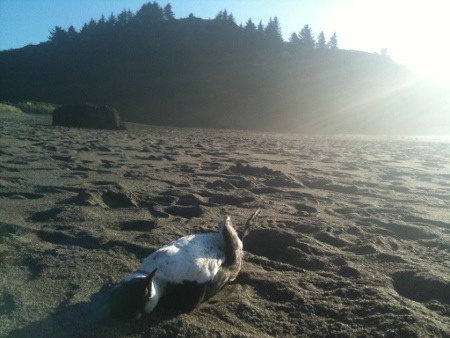News Blog
Murre Hard Times

Common murre, Trinidad State Beach Photo by Ken Malcomson
Oh, cruel, hard Nature, won't you let me wander your beaches without encountering so many of your soft little reminders of Death? Of All Things Must Go? Seriously: Seventeen sleek little feet-up feather bundles laid amidst piles of drying eel grass is quite enough. Their poor breastbones jutting like useless keels from their white bellies. Partly folded stubby black wings seeming to salute the old ocean, or sky. Dark heads lowered, beak to plush chest. Black backs blending with sand-shadow.
Enough! But wait: Perhaps there is someone besides indifferent Mother to blame for these 17 silent common murres tumbled dead onto Trinidad Beach on a fair October day. A dastardly spiller of oil, perhaps? An ocean gill-netter?
Nope. Not in this case, anyway: We have no gill-netting in our open ocean here and there've been no oil spills of late. This time of year, says HSU wildlife professor Richard Golightly, it's quite normal for the bodies of common murres to wash up on beaches up and down the coast.
They're probably teenagers, hatched this spring.
"They fledged off the rock about two months ago, and at this point they're coming on hard times," Golightly says. "Winter's coming and the ocean currents begin to change, and the food changes."
That is, the shifting current can carry the food far from the murres' range. By "the rock," Golightly means any of the rock islands where our local populations breed: Flatiron -- that elongated poop-covered rock you can see straight off of Trinidad Beach -- Pilot Rock (closer to Trinidad Head), Green Rock, White Rock. Those are the ones south of the Klamath River. North of the river, Castle Rock off of Crescent City holds a huge breeding colony of common murres -- last year, 160,000 birds, or 80,000 pairs. From Cape Mendocino to Point St. George, there are roughly 300,000 common murres breeding on offshore rocks. That can yield a lot of chicks. Says Golightly, when you raise that many chicks you're going to have some mortality.
So, yes, scientists are unfazed when the occasional beachcomber calls up to ask about all those fluffy dead murres. Unfazed -- but not cavalier. Says Golightly, just because they're called "common" and are somewhat plentiful and happen to suffer a normal wallop of chick mortality each year, that doesn't meant they're invulnerable to devastation. Those food-stealing current shifts? They could become even more pronounced with climate change. And predation is always a concern -- just picture those 300,000 birds descending each year to breed on their fewer than a dozen rocks.
"There's a bottleneck every year," Golightly says, "where they all show up at the colonies together. If you had somebody stupid enough -- scratch that. If you had somebody unaware enough to go onto one of those rocks during the time they were making eggs, you would end up with a catastrophic failure in the colony. So even though it sounds like a lot of birds, you have 10 or 11 point sources -- colonies -- where they're concentrated and where you could have a problem."
Ah, cruel Nature indeed. Hey, people: Be kind enough to respect these hardworking, risk-taking, chick-losing little fuzzballs of the sea.
Comments